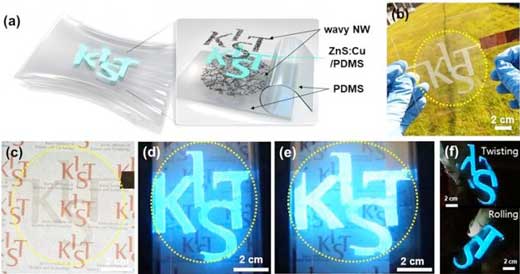| May 06, 2020 | |
Researchers develop large-scale stretchable and transparent electrodes(Nanowerk News) A Korean research team has developed a large-scale stretchable and transparent electrode for the stretchable display. The Korea Institute of Science and Technology (KIST) announced that a research team, led by Dr. Sang-Soo Lee and Dr. Jeong Gon Son at KIST's Photo-Electronic Hybrids Research Center, has developed a technology to fabricate a large-area (larger than an A4 sized paper) wavy silver nanowire network electrode that is structurally stretchable with a high degree of conductivity and transparency (Advanced Functional Materials, "Buckling Instability Control of 1D Nanowire Networks for a Large-Area Stretchable and Transparent Electrode"). |
|
| Transparent electrodes, through which electricity flows, are essential for solar cell- and touchscreen-based display devices. The indium tin oxide (ITO)-based transparent electrode is the one currently commercialized for use. The ITO-based transparent electrode is made of a thin layer of metallic oxides that have very low stretchability and is easy to fragile. Thus, the ITO electrode hard to be used for flexible and wearable devices, which are expected to quickly become mainstream products in the electronic device market. Therefore, it is necessary to develop a new transparent electrode with stretchability as one of its special features. | |
 |
|
| (a-c) Schematic image and photographic images of a logo-patterned stretchable and transparent ZnS:Cu alternating-current electroluminescent (ACEL) device with wavy Ag nanowire-based stretchable and transparent electrodes. (d-f) Electroluminescent image of stretchable and transparent ZnS:Cu ACEL devices under diverse mechanical deformations, including (e) 40% stretching and (f) twisting and rolling. (Image: Korea Institute of Science and Technology) | |
| A silver nanowire is tens of nanometers in diameter, and the nano material itself is long and thin like a stick. The small size of the nanowire allows it to be bent when an external force is applied. Since it is made of silver, silver nanowire has excellent electrical conductivity and can be used in a random network of straight nanowires to fabricate a highly transparent and flexible electrode. However, despite the fact that silver nanowire is bendable and flexible, it cannot be used as a stretchable material. | |
| Other research teams have studied stretchable electrodes using a method of placing silver nanowires on pre-stretched elastic substrates and relaxing the substrates so that they return to their original size, while in the process creating wavy or wrinkled silver nanowire structures with small radius of curvature. | |
| However, this method has one major problem: the nanowires are easily broken by the repeated stretching-relaxing cycles. This problem typically have been approached by increasing the number of nanowires to make a high-density nanowire network so that enough electrical links can still be maintained to use the elastic electrodes, even if the nanowires are partially broken. | |
| However, creating a high-density network considerably decreases transparency and makes it very challenging to fabricate a highly transparent electrode that can be stretched and transformed with both transparency and conductivity. | |
| The KIST research team, led by Dr. Sang-Soo Lee and Dr. Jeong Gon Son, has developed a new process to form a structurally stretchable nanowire network by bringing the nanowire networks in contact with solvents to overcome the problem nanowire breakage and damage when relaxing the pre-stretched substrate. When the solvents are placed on the nanowire networks, they become wet, and there is less frictional resistance between the individual nanowires. | |
| In particular, each silver nanowire can be slid by water and rearranged into a curved nanowire structure with a large radius of curvature, so that a structure capable of stably stretching can be realized. Since the nanowires do not experience any unstable conditions, there are no nanowire network fractures or nanowire layer peeling. | |
| By fabricating a silver nanowire network in this way, the research team was able to stretch the substrate and its nanowires by at least 50% of the initial length, stably maintaining transparency and conductivity for approximately 5 000 stretching-relaxing cycles. The team also found that this type of material could be produced using an inexpensive and environmentally-friendly process that uses ethanol and water as solvents. | |
| The KIST research team used its newly developed process to form a wavy silver nanowire network film on a substrate the size of an A4 paper and succeeded in creating a stretchable and transparent display the size of an adult's hand. The created display maintained its constant luminescence efficiency despite the imposition of various mechanical deformations. Through testing, the team was able to prove the applicability of the new process to all displays that are transparent except for their electroluminescent layer. | |
| Dr. Sang-Soo Lee at KIST said, "The stretchable and transparent electrodes made using wavy silver nanowire networks, developed through this research, have a high degree of electrical conductivity that is not changed by any deformation." KIST's Dr. Jeong Gon Son added, "Since the technology can be used for the mass production, it is expected to have a great impact on markets related to wearable electronic devices, such as high-performance smart wear, and the medical equipment field." |
| Source: Korea Institute of Science and Technology | |
|
Subscribe to a free copy of one of our daily Nanowerk Newsletter Email Digests with a compilation of all of the day's news. |
